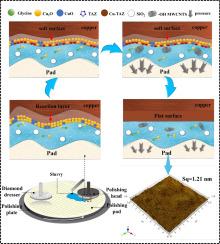功能化MWCNTs作为润滑剂及其与1,2,4-三唑协同作用对铜膜化学机械抛光性能的影响
IF 5.1
3区 材料科学
Q2 MATERIALS SCIENCE, COATINGS & FILMS
引用次数: 0
摘要
为了减少铜化学机械抛光(CMP)过程中的化学物质消耗,提高表面质量,本研究创新性地采用功能化多壁碳纳米管(MWCNTs)作为润滑剂,并与1,2,4-三唑(TAZ)协同作用。通过动态抛光实验确定了最佳TAZ浓度为0.004 wt%,在此浓度下,表面粗糙度(Sq)可达2.15 nm。x射线光电子能谱分析证实,TAZ能在铜表面形成致密的钝化膜,显著抑制过度腐蚀。然而,原子力显微镜测量显示,抛光后表面出现划痕。为了解决这一问题,从力学角度进一步引入了三种功能化MWCNTs (MWCNTs- cooh、MWCNTs- oh、MWCNTs- nh2)。实验结果表明,它们可以通过“滚动润滑-压力缓冲”的协同机制有效改善表面质量,其中MWCNTs-OH表现出最佳性能,进一步将表面粗糙度降低到1.21 nm。这些发现揭示了纳米材料在CMP中新功能的潜在机制。本文章由计算机程序翻译,如有差异,请以英文原文为准。

Effect of functionalized MWCNTs as lubricants and synergy with 1,2,4-Triazole on chemical mechanical polishing properties of copper films
In order to decrease chemical consumption and improve surface quality in copper chemical mechanical polishing (CMP), functionalized multi-walled carbon nanotubes (MWCNTs) were innovatively employed in this study as lubricants and worked in synergy with 1,2,4-triazole (TAZ). The optimal TAZ concentration of 0.004 wt% was determined by dynamic polishing experiments, at which the surface roughness (Sq) could reach 2.15 nm. X-ray photoelectron spectroscopy analysis confirmed that TAZ can form a dense passivation film on copper surfaces, significantly inhibiting excessive corrosion. However, atomic force microscope measurements revealed that scratches appeared on the surface after polishing. To address this, three functionalized MWCNTs (MWCNTs-COOH, MWCNTs-OH, MWCNTs-NH2) were further introduced from a mechanical perspective. Experimental results indicate that they can effectively improve surface quality through a synergistic mechanism of “rolling lubrication-pressure buffering,” with MWCNTs-OH exhibiting the best performance, further reducing surface roughness to 1.21 nm. The findings uncover the underlying mechanisms of nanomaterials' novel functions in CMP.
求助全文
通过发布文献求助,成功后即可免费获取论文全文。
去求助
来源期刊

Diamond and Related Materials
工程技术-材料科学:综合
CiteScore
6.00
自引率
14.60%
发文量
702
审稿时长
2.1 months
期刊介绍:
DRM is a leading international journal that publishes new fundamental and applied research on all forms of diamond, the integration of diamond with other advanced materials and development of technologies exploiting diamond. The synthesis, characterization and processing of single crystal diamond, polycrystalline films, nanodiamond powders and heterostructures with other advanced materials are encouraged topics for technical and review articles. In addition to diamond, the journal publishes manuscripts on the synthesis, characterization and application of other related materials including diamond-like carbons, carbon nanotubes, graphene, and boron and carbon nitrides. Articles are sought on the chemical functionalization of diamond and related materials as well as their use in electrochemistry, energy storage and conversion, chemical and biological sensing, imaging, thermal management, photonic and quantum applications, electron emission and electronic devices.
The International Conference on Diamond and Carbon Materials has evolved into the largest and most well attended forum in the field of diamond, providing a forum to showcase the latest results in the science and technology of diamond and other carbon materials such as carbon nanotubes, graphene, and diamond-like carbon. Run annually in association with Diamond and Related Materials the conference provides junior and established researchers the opportunity to exchange the latest results ranging from fundamental physical and chemical concepts to applied research focusing on the next generation carbon-based devices.
 求助内容:
求助内容: 应助结果提醒方式:
应助结果提醒方式:


